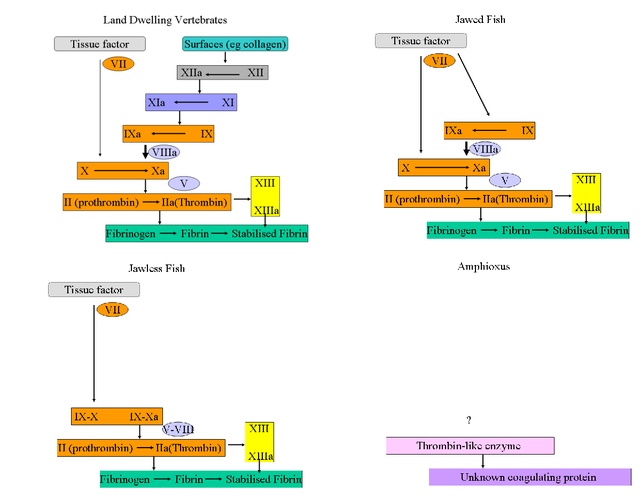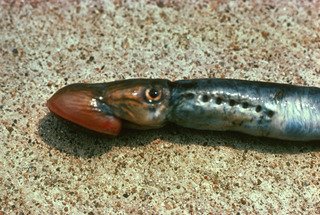Behe vs Lampreys: A modest proposal.
Intelligent Design advocates regularly claim that Intelligent Design is science. However, a recent paper on the lamprey genome demonstrates the sharp gulf between science and ID. One of the key icons of ID is Michael Behe’s “irreducibly complex” clotting system. In 1996 he claimed that the clotting system was unevolvable, and no simpler clotting system could exist. In contrast, in 1987 evolutionary biologist Russell Doolittle hypothesised that the clotting system had been built up by co-option of duplicated genes. Doolittle specifically predicted that fish would lack key elements of the Mammalian clotting system (elements of the intrinsic or contact clotting system). Let’s see how those predictions fared.
Since he first made his prediction, Russell Doolittle has been extensively examining the clotting systems of different organisms. By 2003, after over a decade of hard work, it was apparent that bony fish did lack the intrinsic clotting system, ironically the system that Behe describes in some detail in “Darwins Black Box”. By 2003 it also seemed that jawless fish also lacked key elements of the intrinsic clotting system, in line with Doolittle’s prediction and the opposite of Behe’s claim.
Now, it would have been easy for Doolittle to rest there, with favourable evidence for his prediction. But no, he and his colleagues put it to a more stringent test, searching for clotting factor genes in the trace archive of the lamprey genome (a representative jawless fish). This is a massive bit of work, the trace archive is all the gene fragments generated before assembly of the genome, so they had to laboriously assemble and test each putative gene. What did they find?
That jawless fish lack factors IX and V. Now, this is a pretty important chunk of the clotting system to be without. When it was revealed that whales and bony fish lacked the intrinsic clotting system, Behe effectively replied “So much the worse for them”. But in humans, lack of factor IX produces a bleeding disorder called haemophilia B, lack of factor V also produces haemophilia, and lack of both should result in a very severe bleeding disorder.
 The reducible clotting system: Bony fish and jawless fish have a reduced complement of clotting factors compared to mammals. Jawless fish lack factors IX and V. Tissue factor and factor VII directly activate thrombin, but the explosive coagulation cascade is initiated by factors IX and V acting together. The older name for Factor V was proaccelerin, the activated from of factor V was known as accelerin, indicating its role in the explosive acceleration of clotting.
The reducible clotting system: Bony fish and jawless fish have a reduced complement of clotting factors compared to mammals. Jawless fish lack factors IX and V. Tissue factor and factor VII directly activate thrombin, but the explosive coagulation cascade is initiated by factors IX and V acting together. The older name for Factor V was proaccelerin, the activated from of factor V was known as accelerin, indicating its role in the explosive acceleration of clotting.
Factors IX and V are not peripheral pieces of the clotting system, but are the key section that produces the massive amount of thrombin needed for clotting in vertebrates. According to Behe, the severe bleeding disorder from loss of factors IX and V shows that the clotting system could not be built up from simpler systems, as the system can only function with all its parts.
To put it in Behe’s imagery, the clotting system of the Lamprey is a mousetrap without a spring.
Yet jawless fish are doing quite well without factor IX and V. The implications of this for “irreducible complexity” are profound. An ID advocate might concede that “yes, the clotting system isn’t really irreducibly complex, what about other systems?”. But this example not only falsifies the claim that the clotting system is “irreducibly complex”, but the logic of entire argument Behe uses. Behe has claimed that it is not possible to directly evolve a system such as the clotting system directly, because a smaller system will not work. Yet the jawless fish system shows just that, a system that lacks key component(s) of the mammalian system is completely viable and functioning. Behe’s central argument is broken, knocking out parts of a system and showing that the system breaks does not mean it cannot evolve directly from a simpler system. The work on lampreys provides strong evidence for Doolittle’s model of generating complex systems by rounds of duplication and divergence.
Note that in all this it has been the evolutionary biologists doing the heavy lifting. Generating predictions and models, testing clotting systems in various animals, cloning clotting factors, searching databases and finally, assembling genes from fragments. What have the ID apologists been doing in the 12 years since “Darwins Black Box” was published? Not a lot. Given the central role of the clotting system to their claims, one would have expected the ID folks would have been hard at work showing that the clotting system was irreducible.
Now, to be fair a lot of this is specialized work, that needs a serious biochemistry lab. But when the Fugu genome came out in 2003, nothing was stopping anyone from searching the Fugu genome for clotting factors. The databases were public, and you could do it at home in your spare time. No need to worry about discrimination from co-workers.
Did any ID person do that? No, it was the evolutionary biologists who came up with a testable hypothesis, and combed the Fugu database to test it.
Now the Amphioxus genome has come out. The Amphioxus is a simple, pre-vertebrate chordate, simpler than the Lamprey. We know that it clots its haemolymph (the Amphioxus equivalent of blood), and that it has a thrombin like molecule in its haemolymph, so we know it has a clotting system. Evolutionary biologists would predict that it has a reduced clotting system (see figure). ID advocates would predict that it would not.
So I have a modest proposal. I would like to invite Dr. Behe, or any other ID advocate, to predict which coagulation factors are present in Amphioxus, search the Amphioxus genome database and report on whether the genes found match their predictions. The database is free, you can do it at home, and the only cost is your time.
Time for ID advocates to do some science. How about it?
http://genome.jgi-psf.org/Brafl1/Brafl1.home.html
- Doolittle RF, Jiang Y, Nand J. Genomic evidence for a simpler clotting scheme in jawless vertebrates. J Mol Evol. 2008 Feb;66(2):185-96.
- Jiang Y, Doolittle RF. The evolution of vertebrate blood coagulation as viewed from a comparison of puffer fish and sea squirt genomes. Proc Natl Acad Sci U S A. 2003 Jun 24;100(13):7527-32 (full article free access)
- Doolittle RF.The evolution of vertebrate blood coagulation: a case of Yin and Yang. Thromb Haemost. 1993 Jul 1;70(1):24-8
- Doolittle RF, Feng DF.Reconstructing the evolution of vertebrate blood coagulation from a consideration of the amino acid sequences of clotting proteins.Cold Spring Harb Symp Quant Biol. 1987;52:869-74.
- Davidson CJ, Hirt RP, Lal K, Snell P, Elgar G, Tuddenham EG, McVey JH. (2003). Molecular evolution of the vertebrate blood coagulation network. Thromb Haemost. 89(3):420-8.
- Davidson CJ, Tuddenham EG, McVey JH. 450 million years of hemostasis. J Thromb Haemost. 2003 Jul;1(7):1487-94.

